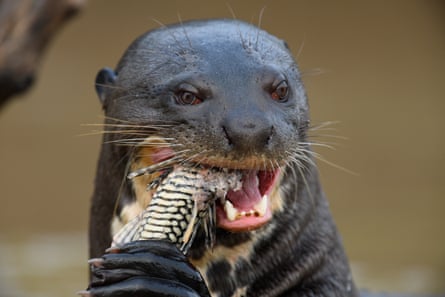“It was a huge surprise,” said Sebastián Di Martino, director of conservation at Fundación Rewilding Argentina. “I was incredulous. An incredible feeling of so much happiness. I didn’t know if I should try to follow it or rush back to our station to tell the others.”
The cause of the excitement was the sighting, last week, of a wild giant river otter – an animal feared extinct in the country due to habitat loss and hunting – on the Bermejo River in Impenetrable national park, in north-east Argentina’s Chaco province. The last sighting of a giant otter in the wild in Argentina was in the 1980s. On the Bermejo, none have been seen for more than a century.
Di Martino captured the otter on his phone while kayaking. “It reared up, so its white chest was visible, which I recognised as the giant river otter [Pteronura brasiliensis]. At this point, your legs go weak and your heart starts beating faster.”
There are two possible explanations for the otter’s return. “The closest known populations of giant otter, which is endangered globally, are in the Paraguayan Pantanal, which could connect with this river from a distance of over 1,000km. That’s the simplest explanation,” said Di Martino. “The other possibility is that there’s a remnant population of the species in Argentina that’s gone undetected. These animals live in family groups, and this was a solitary individual, which we think came from a group.”

Impenetrable national park was created in 2014 with the help of Rewilding Argentina and Tompkins Conservation, the organisation set up by Kristine Tompkins and her late husband, Doug, to restore wild areas of Chile and Argentina using money from their companies, The North Face, Esprit and Patagonia. Tompkins Conservation has helped protect 5.9m hectares (14.5m acres) in South America’s southern cone.
Working with governments and public and private partners, the organisation has helped create 13 national parks, including Corcovado, Pumalin, Yendegaia, Kawésqar and Patagonia in Chile and Monte León and Iberá in Argentina. Impenetrable’s 128,000 hectares (316,000 acres) of native forest and waterways protect remarkable biodiversity in a largely intact section of Gran Chaco forest, one of the world’s most endangered ecosystems. Last year, a lone jaguar, thought to be extinct in the park, was discovered and has since sired cubs.
Otters have a vital role to play in balancing nature. “Giant river otters, as top predators, exert a regulatory influence in the aquatic ecosystem,” said Di Martino. “It’s a regulator of fish populations, which contributes to the health of aquatic ecosystems. It’s a spectacular animal, and it’s enormous; it can be 1.8 metres long. Adults weigh over 30kg. They’re trusting and curious. To share the environment with them is marvellous.”
The otters are so important that, long before this sighting, there were plans to reintroduce them. Rewilding Argentina has been working to bring back giant otters since 2018, concentrating their efforts in Argentina’s Iberá wetlands. Coco and Alondra, a mating pair from Denmark and Hungary, are currently in a pre-release pen there, waiting to enter their vast new home.
The otters are part of a larger ecosystem restoration project to bring back top predators and other species to their native habitats. Six jaguars, the largest predators in South America, were released into Iberá in January and April, the first of nine that will hopefully repopulate the wetlands.
“Given the right circumstances and if the reason an animal went extinct has been removed, you can bring back almost anything,” said Kristine Tompkins. “Our mission is to rewild the Americas, from creating national parks to bringing back those species that have gone missing. It’s a model that can be replicated all over the world. This is how we’re moving the needle in the fight against the species extinction crisis.”
The reappearance of a lone giant otter in Argentina has bolstered the argument that if wild, natural areas are protected, animals will return and life can thrive again, said Di Martino.
“For us, the importance of this sighting is that we’re reminded that we have to protect more of this gem of biodiversity that is Impenetrable national park,” said Di Martino. “The Bermejo River, where this otter was found, is full of illegal hunting and fishing activity. There needs to be more supervision, but also the river has to open up to activities such as tourism, which can provide income to a region that’s very much in need of it. The importance of seeing this otter here again is that it tells us that nature is resilient. If we can help it, there’s hope.”
Find more age of extinction coverage here, and follow biodiversity reporters Phoebe Weston and Patrick Greenfield on Twitter for all the latest news and features